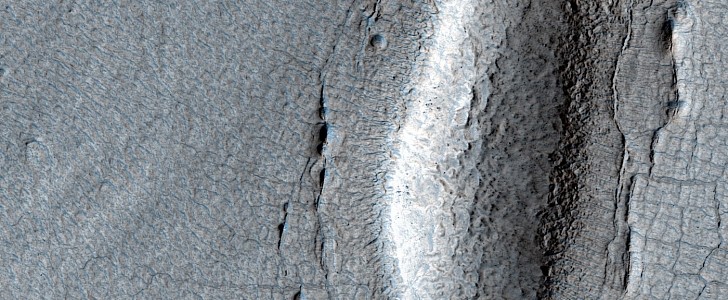There is little doubt Mars once harbored life, but we have no idea what kind of life that might have been. Humans are pretty confident though that whatever shape it might have had, Martian life was never intelligent to the point of making something of its world.
That isn’t stopping Mars geeks from continuously looking at the planet with hope in their eyes, and from jumping from the edge of their seats every time something that looks remotely similar to what intelligence would do surfaces. I should know, I am one of those geeks, and also totally dependent on the brain’s tendency of seeing familiar shapes and patterns where there are none.
Take a look at the potato-shaped feature we have here. It almost looks artificial, placed there, why not, as a means to hide something under the surface. And for all intents and purposes, it does hide something, even if it's not artificial.
The feature is located in the Protonilus Mensae region of Mars, in the planet’s Northern Hemisphere, and is shown as seen through the lens of the HiRISE camera from an altitude of 300 km (186 miles). NASA and the University of Arizona describe this thing as a “lobe-shaped debris apron emanating from a massif.”
Like most other features of this kind, the visible portion is likely made of a layer of debris, but it’s what hides underneath that is of interest to us: “nearly pure water ice.” The blanket of debris protects the water ice from sublimating in the challenging Martian atmosphere, making it of particular interest for scientists here on Earth.
That’s because we humans have begun an all-out hunt for water in the solar system as we plan to harvest it and use it for our missions to other planets. Luckily, NASA estimated not long ago “the Solar System is awash” in the substance, and places like this one on Mars only come to confirm that.
Take a look at the potato-shaped feature we have here. It almost looks artificial, placed there, why not, as a means to hide something under the surface. And for all intents and purposes, it does hide something, even if it's not artificial.
The feature is located in the Protonilus Mensae region of Mars, in the planet’s Northern Hemisphere, and is shown as seen through the lens of the HiRISE camera from an altitude of 300 km (186 miles). NASA and the University of Arizona describe this thing as a “lobe-shaped debris apron emanating from a massif.”
Like most other features of this kind, the visible portion is likely made of a layer of debris, but it’s what hides underneath that is of interest to us: “nearly pure water ice.” The blanket of debris protects the water ice from sublimating in the challenging Martian atmosphere, making it of particular interest for scientists here on Earth.
That’s because we humans have begun an all-out hunt for water in the solar system as we plan to harvest it and use it for our missions to other planets. Luckily, NASA estimated not long ago “the Solar System is awash” in the substance, and places like this one on Mars only come to confirm that.






